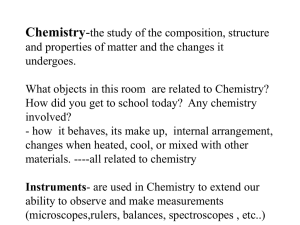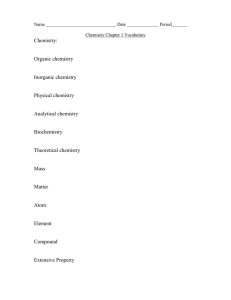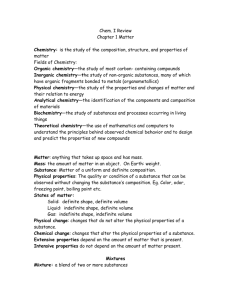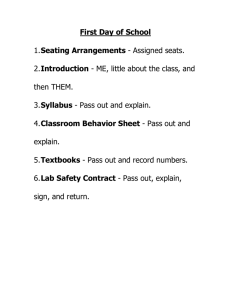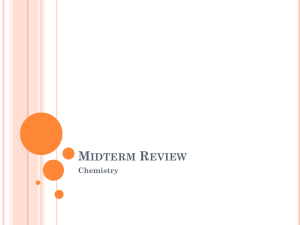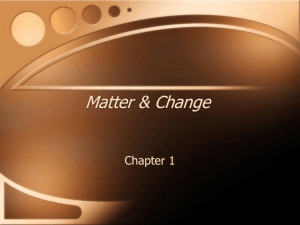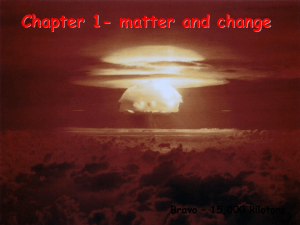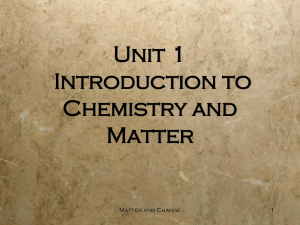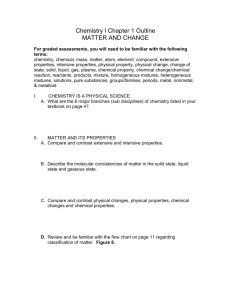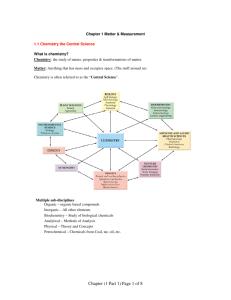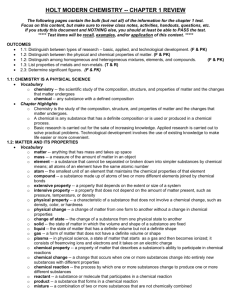Matter and Change: Chemistry Presentation
advertisement
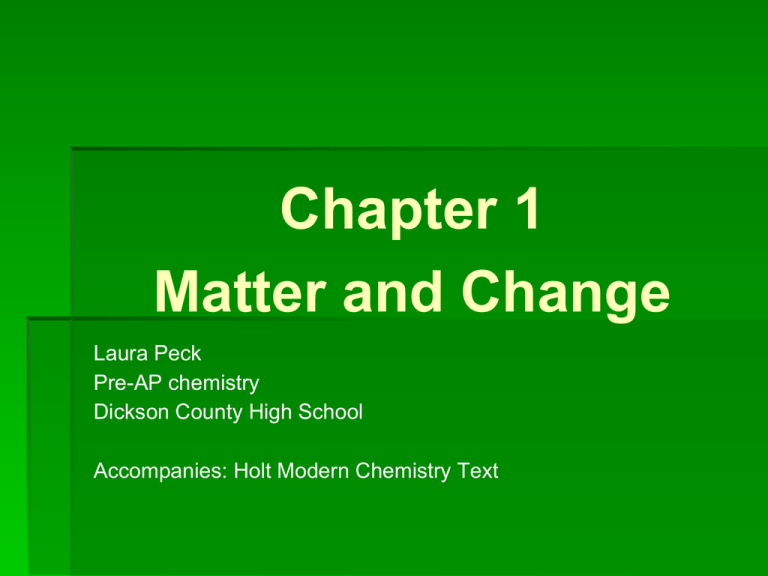
Chapter 1 Matter and Change Laura Peck Pre-AP chemistry Dickson County High School Accompanies: Holt Modern Chemistry Text Objectives ●The science of chemistry ●Matter and its Properties ●Elements Chemistry is a Physical Science ●Chemistry: is the study of the composition, structure, and properties of matter, the processes that matter undergoes, and the energy changes that accompany these processes. Six Branches of Chemistry ●1. Organic: studies carbon molecules created by life. (Petroleum, Plastics, biofuels, etc) ●2. Inorganic: studies non-organic molecules. (organometallics, metal alloys, ion batteries, glass, etc) ●3. Physical: The study of the properties and changes of matter and their relation to energy (plasma TVs, energy production, etc) Six Branches cont……. ●4. Analytical: the identification of the components and composition of materials. (blood testing, water analysis, pollution, EPA, etc) ●5. Biochemistry: the study of substances and processes occurring in living things. (Medical, pharmaceuticals, treatments, allergies, etc) ●6. Theoretical: the use of mathematics and computers to understand the principles behind observed chemical behavior and to design and predict the properties of new compounds. (everything above) 3 Types of Research ●1. Basic Research: carried out for the sake of increasing knowledge. (NASA, HUBBLE, etc) ●2. Applied Research: Generally carried out to solve a problem (developing new drugs.. Etc) ●3. Technological Development: involves the production and use of products that improve our quality of life. (iPads, iPhones, Droids, etc..) Matter and Its Properties ●Atom: smallest unit of an element that maintains the chemical identity of that element. ●Mass: measure of the amount of matter. ●Matter: anything that has mass and takes up space. ●Element: a pure substance that cannot be broken down into simpler, stable substances and is made of one type of atom. ●Compound: substance that can be broken down into simpler stable substances. Made from the atoms of Properties and Changes in Matter ●Extensive properties: depend on the amount of matter that is present. (volume, mass, etc) ●Intensive properties: do not depend on the amount of matter present. (melting point, boiling point, etc) ●Physical Property: characteristic that can be observed or measured without changing the identity of the substance. (melting, boiling, etc) oPhysical Change: change that does not involve a change in the identity of the substance. (cutting, melting, etc) Change of state: physical change from one state another. ●Solid: definite to volume definite shape ●Liquid: definite volume indefinite shape ●Gas: neither definite volume nor shape ●Plasma: high-temperature state where most atoms lose their electrons. Chemical Properties and Chemical Changes ●Chemical properties is the substance’s ability to change into another substance. CO2 H 2O (Oxygen) ●Chemical Change ( ) or Reaction is when substances are converted into other substances oReactants: the ‘ingredients’ – wood, oxygen & heat Energy and Changes in Matter ●Enthalpy is the amount of energy released or absorbed during a chemical or physical change (. ) oTo melt from Ice to liquid, the H2O must absorb energy from the environment. oTo freeze from liquid to ice, the H2O must release energy to the environment. o(energy levels) solid<liquid<gas<plasma oThe Law of Conservation of Energy dictates that energy cannot be created nor destroyed. Classification of Matter ●Mixtures are made from 2 or more substances that retain their identities. o Homogeneous = same throughout o Heterogeneous = not uniform ●Pure Substance has fixed composition and the same characteristic properties throughout. o Compound = 2 or more elements chemically bonded together Laboratory Chemicals and Purity ●Grades of Purity, but none are 100% pure ● You NEVER EVER Return a reagent back To the original bottle. This will contaminate The purity of your Master reagent! Primary Standard Reagents highest ACS (American Chemical Society Specified reagents) USP (U.S. Pharmacopoeia standard) CP (Chemically Pure) NF (National Formulary specifications) FCC (Food Chemical Code specifications) Technical (industrial chemicals) lowest Elements ●Groups/families: vertical columns oSimilar chemical properties ●Periods: horizontal rows oPhysical/chemical properties change regularly across. … … … … ……………………………………………………………………………. … … … … … . … . Types of Elements ●Metals: an element that is a good electrical conductor and heat conductor. Properties: most are solid at room Temperature, malleability, ductile, Tensile strength, luster. Discuss the differences between Copper and mercury. ●Nonmetals: poor conductors of heat and electricity. oMany are gases at room temperature. Bromine is a liquid. Carbon, Phosphorous, selenium, sulfur and iodine are solids. oTend to be brittle. ●Metalloids: Has some characteristics of metals and some characteristics of nonmetals. oSolid at room temperature, less malleable, semiconductors, some have luster. Which metalloid is Essential for our Computer-driven Technology? What State has a Valley named ●Noble Gases: Part of the nonmetals, these elements are gases at room temperature. oGenerally unreactive with other elements Which noble gas is Close to ‘running out’ In commercial production? Discuss why its production Is limited by radioactive Decay.
